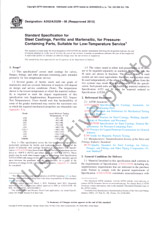We need your consent to use the individual data so that you can see information about your interests, among other things. Click "OK" to give your consent.
ASTM E3343/E3343M-22
Test Methods for Nonballistic-resistant Helmets Worn by Law Enforcement and Corrections
Translate name
STANDARD published on 1.3.2022
The information about the standard:
Designation standards: ASTM E3343/E3343M-22
Note: WITHDRAWN
Publication date standards: 1.3.2022
SKU: NS-1052972
The number of pages: 21
Approximate weight : 63 g (0.14 lbs)
Country: American technical standard
Category: Technical standards ASTM
Annotation of standard text ASTM E3343/E3343M-22 :
Keywords:
blunt impact, corrections, head protection, helmet, law enforcement,, ICS Number Code 13.340.20 (Head protective equipment)
Additional information
| Significance and Use |
|
4.1?The purpose of these test methods is to provide reliable and repeatable nonballistic test methods and conditioning procedures for the evaluation of head protection used in law enforcement and corrections applications. 4.2?It is anticipated that these test methods will be referenced by certifiers, purchasers, or other users in order to meet their specific needs. Those users will specify which test methods and conditioning procedures are applicable, and will specify any performance categories or levels. 4.3?These test methods include some procedures and references to other standards to ensure that relevant properties are addressed. |
| 1. Scope |
|
1.1?This standard provides nonballistic test methods and conditioning procedures for assessing head protection (that is, helmet and face shield) worn by law enforcement and corrections officers. 1.1.1?Conditioning procedures are included to assess durability in terms of resistance to chemicals and cleaning products, extreme temperatures, weathering, and absorption of liquids. 1.1.2?Test methods are included to assess the protective performance against hazards including impact/bump, projectiles (other than bullets), flame, and liquids. 1.1.3?Test methods are included to assess safety and ergonomic aspects of retention system strength, stability of the helmet on the wearers head, corrosion resistance, and face shield visual acuity, field of view, scratch resistance, and anti-mist properties. Note 1:?These test methods reference published standards from
ASTM International and other standards developing organizations.
Appendix X1 contains a
summary of test methods included in this standard, along with the
source and purpose for each.
1.2?These test methods do not address eye protection other than face shields that are attached to the helmet. 1.3?It is anticipated that these test methods will be referenced by suppliers, certifiers, purchasers, or other users to meet their specific needs. Those users will specify, in other standards and specifications, which test methods and conditioning procedures are applicable and will specify any performance categories or levels. 1.3.1?If there is a discrepancy between these test methods and a user-supplied document, the user-supplied document shall take precedence. 1.4?In these test methods, other standards and specifications and unless specified elsewhere refer to documents (for example, military standards, purchase specifications) that require the use of these test methods. Purchasers and other users are responsible for the other standards and specifications and for specifying any requirements that supersede those of these test methods. 1.5?UnitsThe values stated in either SI units or inch-pound units are to be regarded separately as standard. The values stated in each system are not necessarily exact equivalents; therefore, to ensure conformance with the standard, each system shall be used independently of the other, and values from the two systems shall not be combined. 1.6?This standard does not purport to address all of the safety concerns, if any, associated with its use. It is the responsibility of the user of this standard to establish appropriate safety, health, and environmental practices and determine the applicability of regulatory limitations prior to use. 1.7?This international standard was developed in accordance with internationally recognized principles on standardization established in the Decision on Principles for the Development of International Standards, Guides and Recommendations issued by the World Trade Organization Technical Barriers to Trade (TBT) Committee. |
We recommend:
Technical standards updating
Do you want to make sure you use only the valid technical standards?
We can offer you a solution which will provide you a monthly overview concerning the updating of standards which you use.
Would you like to know more? Look at this page.




 Cookies
Cookies
